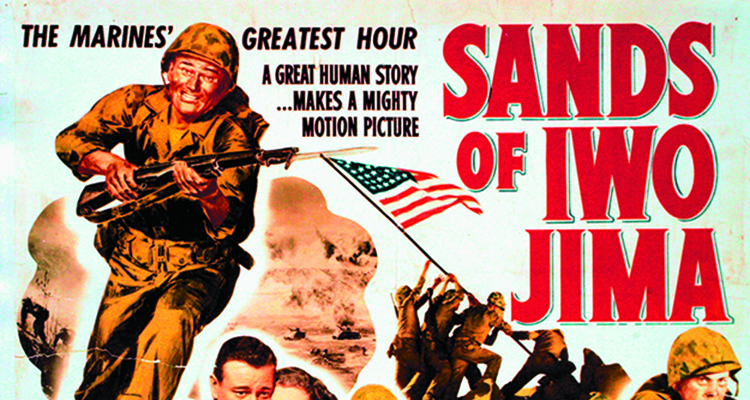THE NEXT TIME you’re talking war movie trivia with friends, ask, “Who is the hero in Sands of Iwo Jima?” Almost inevitably, someone will say, “John Wayne.” Or perhaps “Sergeant Stryker,” since that’s the name of the character Wayne portrays. Either answer will be wrong. Although Stryker is the film’s central figure, the hero is the entire Marine rifle squad he leads into battle. The film’s story unfolds most richly when this is understood.
The ideas of mythologist Joseph Campbell offer that understanding. In 1949—the year Sands of Iwo Jima debuted—Campbell published The Hero with a Thousand Faces. Studying cultures the world over, Campbell discovered that each had stories of a hero on a journey of adventure that shared a common structure. In mythic terms “Hero” means more than behaving heroically: a mythological hero is a character who undergoes an adventure that challenges and changes him, and from which he returns with a “boon”—that is, something of lasting value for himself or for others. “A hero,” Campbell said, “is someone who has given his or her life to something bigger than oneself.”
Although you may never have heard of Campbell’s book or his terminology, you’ve surely seen his ideas on display, because in creating his Star Wars trilogy, writer/producer George Lucas consciously drew upon them. The Hero (Luke Skywalker) leaves the “ordinary world” of the planet Tatooine, enters the “special world” of the adventure, learns to operate in that world thanks to a Mentor (Obi-Wan Kenobi), fights an adversary (the Empire), reaches a point of maximum peril (the loss of a hand and of his friend, Han Solo), and finally defeats his adversary and brings the boon of enduring peace to the galaxy.
Although Campbell was the first to delineate this structure, storytellers have intuitively used it for millennia. So it was with Sands of Iwo Jima, written by Harry Brown and James Edward Grant, and directed by Allan Dwan.
The film opens in the “ordinary world” of a Marine Corps training camp in New Zealand. The rifle squad—in mythic terms, the Hero Team, whose members embark on the adventure together—are the first characters introduced. Only then does Sergeant John M. Stryker appear. Stryker’s task is to prepare the Hero Team to enter the “special world” of combat—making him their Mentor. He underscores this when he and the squad first meet: “If I can’t teach you one way, I’ll teach you another. But I’ll get the job done.” And frequently invoking his catchphrase—“Saddle up!”—Stryker proceeds to do exactly that.
Save for the squad’s two combat veterans, the men do not particularly like Stryker. Nor does he try to make himself likeable. He even strikes Private First Class “Sky” Choynski (Hal Baylor) with the butt of his rifle when the private fumbles the footwork involved in a bayonet drill. But true to his word, if Stryker can’t teach Choynski one way, he’ll teach him another. Later in the film he has Choynski shuffle to the tune of the “Mexican Hat Dance” to give Choynski a sense of the rhythm and shifting of body weight involved.
As with the Star Wars trilogy, many mythic adventures involve not only a Mentor but a Shadow Mentor, who tries to induce the Hero into embracing the special world’s dark side. In Star Wars, the Shadow Mentor is Darth Vader. In Sands of Iwo Jima, Stryker is both Mentor and Shadow Mentor—a characterization that illuminates the film’s central conflict, that between Stryker and Private First Class Peter Conway (John Agar). Most rifle squad members see only the Mentor, but Conway clearly perceives the Shadow Mentor—helped by the fact that Stryker strongly reminds Conway of his father, a flinty Marine colonel under whose command Stryker served on Guadalcanal. Of his father, Conway speaks bitterly. “I wasn’t tough enough for him. Too soft. ‘No guts’ was the phrase he used. He wanted me to be like Stryker…. I bet they got along just fine. Both with ramrods strapped on their backs…. They’re not going to strap one on mine.” Conway views Stryker as the embodiment of man the violent animal as opposed to man the lover of life, family, and culture.
Conway directly encounters the Shadow Mentor the night after the Tarawa landings. This is the point of maximum peril for the Hero Team, for headquarters has assigned the squad to hold a sector that requires a force three times larger. In the midst of this tense situation, Conway and Stryker hear a wounded comrade cry out. Stryker refuses to help, saying that the cry may be a ruse and that attempting rescue would give away the squad’s position. To Conway, this response is inhuman. “Sit here if you want,” he says, “I’m getting him. The only way you’ll stop me is to kill me.” Stryker turns his rifle on Conway, his expression one of icy malevolence: “That’s just what I’ll do!” Conway stays put.
Success at Tarawa achieved, the squad returns to its training camp, ultimately to be thrown into desperate combat again, this time on Iwo Jima. In the film’s climactic scenes, the squad supports the patrol carrying the Stars and Stripes to the summit of Mount Suribachi. In that fight, Stryker is killed. As the squad huddles around his body, the men watch the flag rise, an act symbolic of the American triumph over Japan and the mythic boon of peace.
Then Conway steps forward to lead them. “All right, saddle up!” he growls, using Stryker’s trademark phrase. “Let’s get back in the war.” The squad has completed the Hero’s adventure. But a knowledge of mythic structure leaves us wondering what journey Conway himself has completed. Has he embraced Stryker as Mentor after all? Or has he embraced the Shadow Mentor? Perhaps, as Campbell once expressed it, Conway has “put aside his pride, his virtue, beauty and life” and has at last submitted “to the absolutely intolerable.”
Originally published in the July/August 2014 issue of World War II magazine. Subscribe here.





